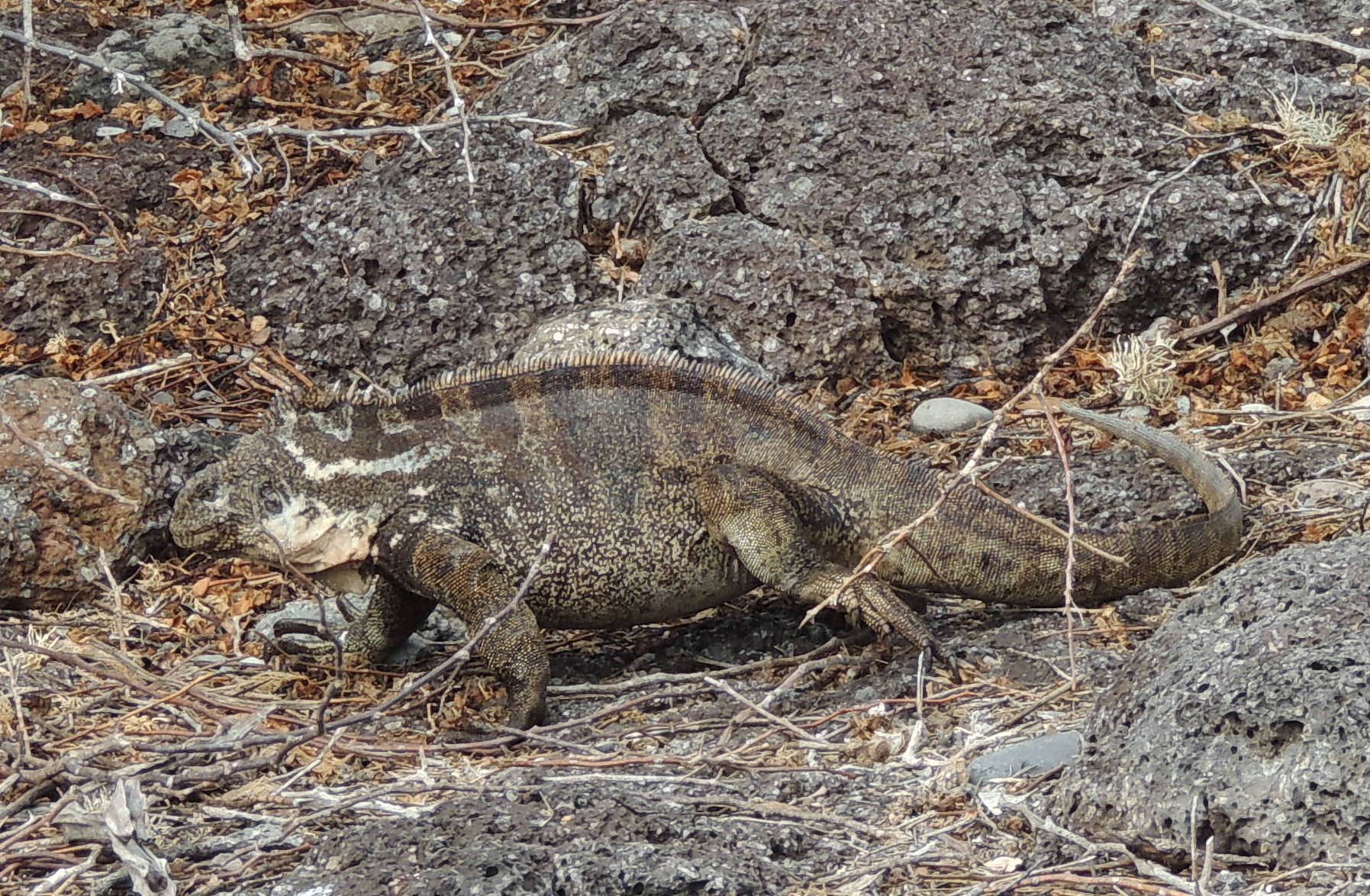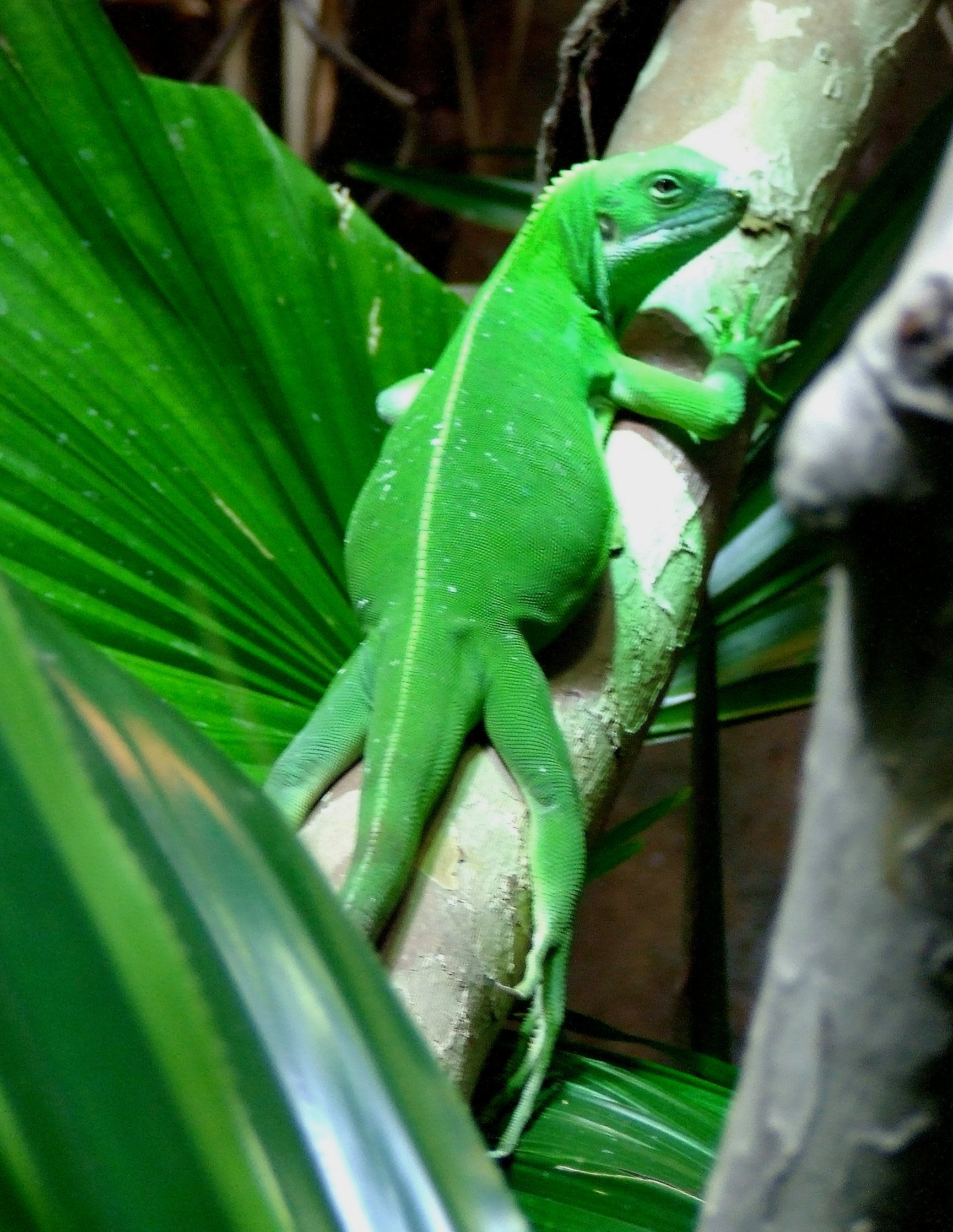|
Iguanidae
The Iguanidae is a family of lizards composed of the iguanas, chuckwallas, and their prehistoric relatives, including the widespread green iguana. Taxonomy Iguanidae is thought to be the sister group to the Crotaphytidae, collared lizards (family Crotaphytidae). This family likely first appeared in Cenozoic, previously identified two Cretaceous genera (''Pristiguana'' and ''Pariguana'') are unlikely to belong to this family. The subfamily Iguaninae, which contains all modern genera, likely originated in the earliest Paleocene, about 62 million years ago. The most Basal (phylogenetics), basal extant genus, ''Desert iguana, Dipsosaurus,'' diverged from the rest of Iguaninae during the late Eocene, about 38 million years ago, with ''Brachylophus'' following a few million years later at about 35 million years ago, presumably after its dispersal event to the Pacific Ocean, Pacific. All other modern iguana genera formed in the Neogene period. A phylogenetic tree of Iguaninae is shown ... [...More Info...] [...Related Items...] OR: [Wikipedia] [Google] [Baidu] |
Green Iguana
The green iguana (''Iguana iguana''), also known as the American iguana or the common green iguana, is a large, arboreal, mostly Herbivory, herbivorous species of lizard of the genus ''Iguana''. Usually, this animal is simply called the iguana. The green iguana ranges over a large geographic area; it is native from southern Brazil and Paraguay as far north as Mexico. A herbivore, it has adapted significantly with regard to locomotion and osmoregulation as a result of its diet. It grows to in length from head to tail, although a few specimens have grown more than with bodyweights upward of . Commonly found in captivity as a pet due to its calm disposition and bright colors, it can be very demanding to care for properly. Space requirements and the need for special lighting and heat can prove challenging to the hobbyist. Taxonomy The species was first officially described by Swedish botanist Carl Linnaeus in 1758. Since then, numerous subspecies have been identified, but later ... [...More Info...] [...Related Items...] OR: [Wikipedia] [Google] [Baidu] |
Iguana
''Iguana'' (, ) is a genus of herbivorous lizards that are native to tropical areas of Mexico, Central America, South America, and the Caribbean. The genus was first described by Austrian naturalist Josephus Nicolaus Laurenti, J.N. Laurenti in 1768. Two species are placed in the genus: The green iguana, which is widespread throughout its range and a popular pet; and the Lesser Antillean iguana, which is native to the Lesser Antilles. Genetic analysis indicates that the green iguana may comprise a species complex, complex of multiple species, some of which have been recently described, but the Reptile Database considers all of these as subspecies of the green iguana. The word "iguana" is derived from the original Taíno people, Taino name for the species, ''iwana''. In addition to the two species in the genus ''Iguana'', several other related genera in the same family have common names of the species including the word "iguana". The species is a popular quarry for pets, and no ... [...More Info...] [...Related Items...] OR: [Wikipedia] [Google] [Baidu] |
Amblyrhynchus
The marine iguana (''Amblyrhynchus cristatus''), also known as the sea iguana, saltwater iguana, or Galápagos marine iguana, is a species of iguana found only on the Galápagos Islands (Ecuador). Unique among modern lizards, it is a marine reptile that has the ability to forage in the sea for algae, which make up almost all of its diet. Marine iguanas are the only extant lizard that spends time in a marine environment. Large males are able to dive to find this food source, while females and smaller males feed during low tide in the intertidal zone. They mainly live in colonies on rocky shores where they bask after visiting the relatively cold water or intertidal zone, but can also be seen in marshes, mangrove swamps and beaches. Large males defend territories for a short period, but smaller males have other breeding strategies. After mating, the female digs a nest hole in the soil where she lays her eggs, leaving them to hatch on their own a few months later. Marine iguanas vary ... [...More Info...] [...Related Items...] OR: [Wikipedia] [Google] [Baidu] |
Brachylophus
The genus ''Brachylophus'' consists of four Extant taxon, extant iguanid species native to the islands of Fiji and a giant extinct species from Tonga in the South West Pacific. One of the extant species, ''B. fasciatus'', is also present on Tonga, where it has apparently been introduced by humans. Etymology and taxonomy The name, ''Brachylophus'', is derived from two Greek words: brachys (βραχύς) meaning "short" and lophos (λόφος) meaning "crest" or "plume", denoting the short spiny crests found along the backs of these species. ''Brachylophus'' species are the most geographically isolated iguanas in the world. Their closest extant relatives (the genera ''Amblyrhynchus'', ''Conolophus'', ''Ctenosaura'', ''Cyclura'', ''Iguana'' and ''Sauromalus'') are present in primarily tropics, tropical regions of the Americas and islands in the Galápagos Islands, Galápagos and Lesser Antilles, Lesser and Greater Antilles. Several of these genera are adapted to Deserts and xeric s ... [...More Info...] [...Related Items...] OR: [Wikipedia] [Google] [Baidu] |
Marine Iguana
The marine iguana (''Amblyrhynchus cristatus''), also known as the sea iguana, saltwater iguana, or Galápagos marine iguana, is a species of Iguanidae, iguana found only on the Galápagos Islands (Ecuador). Unique among modern lizards, it is a marine reptile that has the ability to forage in the sea for algae, which make up almost all of its diet. Marine iguanas are the only extant lizard that spends time in a marine environment. Large males are able to dive to find this food source, while females and smaller males feed during low tide in the intertidal zone. They mainly live in Colony (biology), colonies on rocky shores where they bask after visiting the relatively cold water or intertidal zone, but can also be seen in marshes, mangrove swamps and beaches. Large males defend Territory (animal), territories for a short period, but smaller males have other breeding strategies. After mating, the female digs a nest hole in the soil where she lays her eggs, leaving them to hatch on th ... [...More Info...] [...Related Items...] OR: [Wikipedia] [Google] [Baidu] |
Desert Iguana
The desert iguana (''Dipsosaurus dorsalis'') is an iguana species found in the Sonoran and Mojave Deserts of the Southwestern United States and northwestern Mexico, as well as on several Gulf of California islands. Taxonomy The species was first described in the ''Proceedings of the Academy of Natural Sciences of Philadelphia'', by Spencer Fullerton Baird and Charles Frédéric Girard, in 1852 as ''Crotaphytus dorsalis''. It was reclassified two years later as ''Dipsosaurus dorsalis'' by Edward Hallowell. The generic name comes from a combination of two Greek words meaning "thirsty lizard": "" () for "thirsty", and "" () for "lizard". The specific name, "dorsalis", comes from the Latin word ''dorsum'' meaning "spike", in reference to a row of enlarged spiked scales on the middle of the lizard's back which form a crest that extends almost to the tip of its vent. ''Dipsosaurus'' contains two species, ''D. dorsalis'', and ''D. catalinensis''. Genetic evidence supports ''Dipsos ... [...More Info...] [...Related Items...] OR: [Wikipedia] [Google] [Baidu] |
Conolophus
''Conolophus'' is a genus of lizards, also known commonly as Galápagos land iguanas, in the family Iguanidae. The genus is endemic to the Galápagos Islands of Ecuador. The number of species A species () is often defined as the largest group of organisms in which any two individuals of the appropriate sexes or mating types can produce fertile offspring, typically by sexual reproduction. It is the basic unit of Taxonomy (biology), ... of this variable genus has always been disputed; the most current taxonomic surveys suggest that three species exist. Extant species References Further reading * Frost, D.R.; Etheridge, R. (1989). "A Phylogenetic Analysis and Taxonomy of Iguanian Lizards (Reptilia: Squamata)". ''University of Kansas Museum of Natural History, Miscellaneous Publications'' (81): 1–65. *Frost, D.R.; Etheridge, R.; Janies, D.; Titus, T.A. (2001) "Total Evidence, Sequence Alignment, Evolution of Polychrotid Lizards, and a Reclassification of the Iguan ... [...More Info...] [...Related Items...] OR: [Wikipedia] [Google] [Baidu] |
Ctenosaura
''Ctenosaura'' is a lizard genus commonly known as spinytail iguanas or ctenosaurs. The genus is part of the large lizard family Iguanidae and is native to Mexico and Central America. The name is derived from two Greek words: (), meaning "comb" (referring to the comblike spines on the lizard's back and tail), and (), meaning "lizard". Description The species range in size (total length, including the tail) from about to well over . The distinctive feature of this genus is the presence of enlarged, spiny scales on the tail. Ecology and natural history Ctenosaurs are generally omnivorous, feeding on fruits, flowers, foliage, and small animals. While studying physiological correlates of locomotion in lizards, a "burst speed" of 34.6 km/h (21.5 miles/h) was recorded by a black spiny-tail iguana ('' Ctenosaura similis''), which is the highest speed reported for a lizard.Garland, Theodore., Jr. 1984. ''Physiological correlates of locomotory performance in a lizard: an allom ... [...More Info...] [...Related Items...] OR: [Wikipedia] [Google] [Baidu] |
Basal (phylogenetics)
In phylogenetics, basal is the direction of the ''base'' (or root) of a phylogenetic tree#Rooted tree, rooted phylogenetic tree or cladogram. The term may be more strictly applied only to nodes adjacent to the root, or more loosely applied to nodes regarded as being close to the root. Note that extant taxa that lie on branches connecting directly to the root are not more closely related to the root than any other extant taxa. While there must always be two or more equally "basal" clades sprouting from the root of every cladogram, those clades may differ widely in taxonomic rank, Phylogenetic diversity, species diversity, or both. If ''C'' is a basal clade within ''D'' that has the lowest rank of all basal clades within ''D'', ''C'' may be described as ''the'' basal taxon of that rank within ''D''. The concept of a 'key innovation' implies some degree of correlation between evolutionary innovation and cladogenesis, diversification. However, such a correlation does not make a given ca ... [...More Info...] [...Related Items...] OR: [Wikipedia] [Google] [Baidu] |
Pariguana
''Pariguana'' (meaning "near ''Iguana''" in Greek) is an extinct genus of iguanomorph lizard from the Late Cretaceous of western North America. It is known from a single type species, ''Pariguana lancensis'', named in 2012 on the basis of a partial lower jaw from the Lance Formation in eastern Wyoming. This jaw bone comes from a layer dated approximately 650,000 years before the Cretaceous–Paleogene extinction event. ''Pariguana'' was originally considered as the oldest definitive iguanid pleurodontan from North America, and may represent the first stage of the iguanian evolutionary radiation An evolutionary radiation is an increase in taxonomic diversity that is caused by elevated rates of speciation, that may or may not be associated with an increase in morphological disparity. A significantly large and diverse radiation within ... from Asia into North America. However, later phylogenic analysis suggests that it is not pleurodontan although likely to be an iguanomorph ... [...More Info...] [...Related Items...] OR: [Wikipedia] [Google] [Baidu] |








